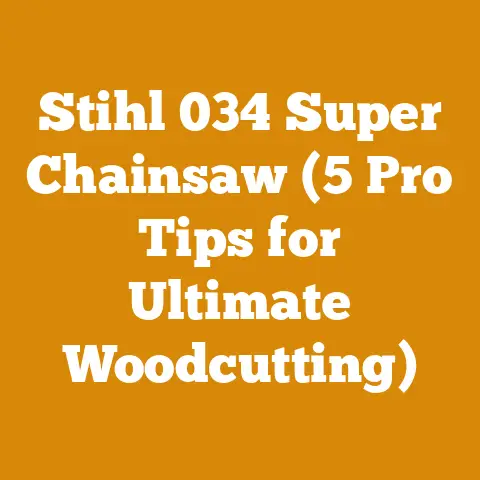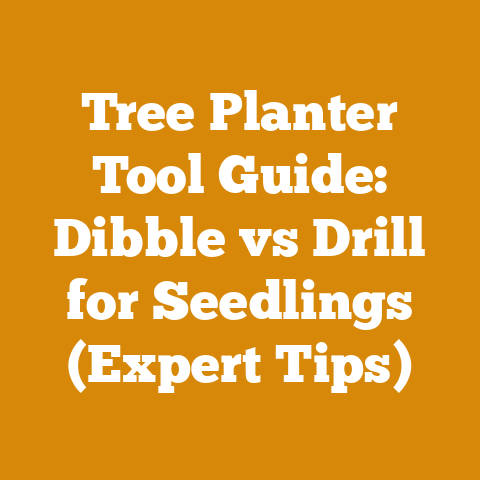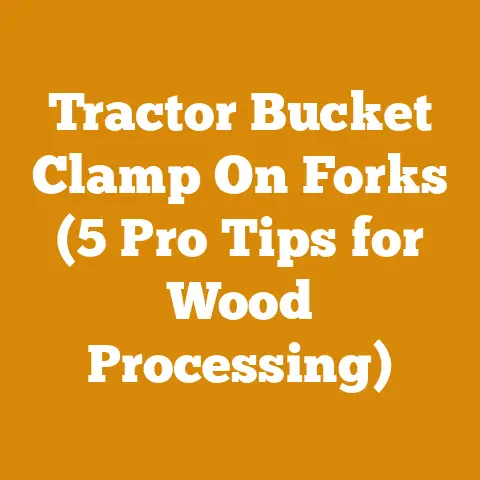How to Kill Honeysuckle (5 Pro Logging Tricks Revealed)
Alright, let’s dive into how to tackle that invasive honeysuckle problem, but with a mindful approach. I always believe in starting with the least impactful methods first, preserving our ecosystems whenever possible. Before we get into the “pro logging tricks,” let’s consider some eco-friendly options. Simple hand-pulling of young plants, diligent cutting back, and even smothering with cardboard can be effective for smaller infestations. These methods require patience and persistence, but they’re gentler on the environment and prevent the unintended consequences that can sometimes arise from more aggressive approaches. Now, let’s get into the heavier artillery when those methods aren’t enough.
How to Kill Honeysuckle: 5 Pro Logging Tricks Revealed
Honeysuckle. The name sounds sweet, almost innocent, doesn’t it? But trust me, as someone who’s spent years wrestling with it in various woodlots and forests, I can tell you it’s anything but. This invasive vine can quickly choke out native plants, smother young trees, and turn a thriving ecosystem into a tangled mess. Over the years, I’ve learned a few tricks from experienced loggers – techniques that go beyond your average gardening advice. These methods are effective, but remember, they should be used responsibly and strategically, especially considering the potential impact on the surrounding environment.
Understanding the Enemy: Honeysuckle Biology and Behavior
Before we go hacking and spraying, let’s understand what we’re up against. Honeysuckle is a master of survival. It spreads through seeds (birds love those berries!) and also vegetatively, meaning new plants can sprout from roots and stems. This is why simply cutting it back rarely solves the problem. You’re just giving it a haircut!
There are several species of invasive honeysuckle in North America, including Amur honeysuckle (Lonicera maackii), Japanese honeysuckle (Lonicera japonica), and Morrow’s honeysuckle (Lonicera morrowii). Each has its own quirks, but they all share a common goal: to dominate.
- Amur Honeysuckle: This shrubby honeysuckle is particularly aggressive, forming dense thickets that shade out native vegetation.
- Japanese Honeysuckle: A vine that climbs and smothers everything in its path, from trees to groundcover.
- Morrow’s Honeysuckle: Similar to Amur honeysuckle, it forms dense thickets and is highly adaptable to different soil conditions.
Data Point: A study by the University of Illinois found that Amur honeysuckle can reduce native plant diversity by up to 75% in infested areas. That’s a staggering loss!
Personal Story: I remember one particular woodlot I was managing. It had been neglected for years, and the honeysuckle had completely taken over. It was like walking into a green, tangled cave. The native wildflowers were gone, the young trees were struggling, and the whole place felt… lifeless. That’s when I realized I needed to bring out the big guns.
Trick #1: The Cut-Stump Herbicide Treatment
This is a go-to method for many loggers, and it’s highly effective when done correctly. The idea is simple: cut the honeysuckle stem close to the ground and immediately apply herbicide to the freshly cut surface. This allows the herbicide to be absorbed directly into the root system, killing the entire plant.
-
Equipment:
- Chainsaw or brush saw (for larger stems)
- Hand pruners or loppers (for smaller stems)
- Herbicide (glyphosate or triclopyr are common choices, but always check local regulations and recommendations)
- Small spray bottle or paintbrush
- Gloves and eye protection (always!)
-
Wood Types (Not Applicable Here): We’re dealing with honeysuckle, not timber, so wood type isn’t a factor.
-
Safety Considerations:
- Always wear appropriate personal protective equipment (PPE), including gloves, eye protection, and long sleeves.
- Be careful when using chainsaws or brush saws. Follow all safety guidelines and never work alone.
- Read and understand the herbicide label before use. Apply only as directed and avoid spraying on non-target plants.
- Consider the weather conditions. Avoid spraying on windy days or when rain is expected.
-
Why it Works: The cut-stump method bypasses the plant’s defenses and delivers the herbicide directly to the root system. This is much more effective than foliar spraying, which can be less efficient and more likely to drift onto other plants.
-
Example: I was working on a project in a mixed hardwood forest where honeysuckle was encroaching on a patch of valuable oak seedlings. We used the cut-stump method with glyphosate, carefully applying the herbicide to each cut stem. Within a few weeks, the honeysuckle was dead, and the oak seedlings had a chance to thrive.
Data Point: Studies have shown that the cut-stump method can achieve up to 90% kill rate for honeysuckle when using appropriate herbicides and application techniques.
Trick #2: Basal Bark Treatment
This method is best for smaller honeysuckle stems (less than 6 inches in diameter) and involves applying herbicide directly to the bark near the base of the plant. The herbicide is absorbed through the bark and into the vascular system, killing the plant.
-
Equipment:
- Herbicide (specifically formulated for basal bark treatment, usually containing triclopyr ester)
- Low-pressure backpack sprayer or handheld sprayer
- Gloves and eye protection
-
Wood Types (Not Applicable Here): Again, we’re dealing with honeysuckle, not timber.
-
Safety Considerations:
- Wear appropriate PPE, including gloves, eye protection, and long sleeves.
- Read and understand the herbicide label before use. Apply only as directed.
- Avoid spraying on non-target plants.
- Be mindful of the weather conditions. Avoid spraying on windy days or when rain is expected.
-
Why it Works: The bark of honeysuckle is relatively thin, allowing the herbicide to penetrate and reach the vascular system. This method is less labor-intensive than the cut-stump method, as you don’t have to cut each stem.
-
Example: I used basal bark treatment on a large honeysuckle infestation along a fencerow. The stems were too numerous to cut individually, so spraying the base of each stem was the most efficient option. Within a few months, the honeysuckle had died back, and the fencerow was clear.
Data Point: Basal bark treatment can be effective on honeysuckle stems up to 6 inches in diameter, with kill rates ranging from 70% to 90% depending on the herbicide and application technique.
Trick #3: Foliar Spraying (Use with Caution)
Foliar spraying involves applying herbicide directly to the leaves of the honeysuckle. This method is best for large infestations where other methods are impractical, but it should be used with caution, as it can easily damage non-target plants.
-
Equipment:
- Herbicide (glyphosate or triclopyr)
- Backpack sprayer or handheld sprayer
- Surfactant (to help the herbicide stick to the leaves)
- Gloves and eye protection
-
Wood Types (Not Applicable Here): Still fighting honeysuckle, not cutting timber.
-
Safety Considerations:
- Wear appropriate PPE, including gloves, eye protection, and long sleeves.
- Read and understand the herbicide label before use. Apply only as directed.
- Avoid spraying on non-target plants. Use a shield or targeted nozzle to minimize drift.
- Be mindful of the weather conditions. Avoid spraying on windy days or when rain is expected.
- Spray during the growing season when the honeysuckle is actively growing.
-
Why it Works (Sometimes): Foliar spraying can be effective if the honeysuckle is actively growing and the herbicide is applied evenly to all the leaves. However, it’s often less effective than other methods because the herbicide may not reach the root system.
-
Example: I had a particularly dense honeysuckle infestation in a remote area where access was difficult. We used foliar spraying as a last resort, carefully targeting the honeysuckle and avoiding spraying on nearby native plants. The results were mixed – some of the honeysuckle died back, but we had to follow up with other methods to completely eradicate it.
Data Point: Foliar spraying can be effective on honeysuckle, but it often requires multiple applications and may not achieve the same kill rates as cut-stump or basal bark treatment. Success rates can vary from 50% to 80% depending on the herbicide, application technique, and environmental conditions.
Unique Insight: One trick I learned from an old-timer is to add a blue dye to the herbicide mix when foliar spraying. This helps you see where you’ve already sprayed and prevents over-application. It also makes it easier to avoid spraying on non-target plants.
Trick #4: Prescribed Burning (For the Experienced)
Prescribed burning is a controlled fire used to manage vegetation. It can be an effective way to kill honeysuckle, especially in large areas, but it requires specialized knowledge and equipment. This is definitely not a DIY project for beginners.
-
Equipment:
- Drip torch
- Backpack water sprayer
- Fire rake
- Weather monitoring equipment
- Communication devices
- Trained personnel
-
Wood Types (Relevant to the Overall Ecosystem): Prescribed burning can benefit certain wood types, such as oak and pine, by reducing competition from honeysuckle and other invasive species.
-
Safety Considerations:
- Prescribed burning is extremely dangerous and should only be conducted by trained professionals.
- Obtain all necessary permits and follow all local regulations.
- Develop a detailed burn plan that includes safety protocols, weather conditions, and contingency plans.
- Notify local authorities and neighbors before conducting a burn.
- Monitor the fire closely and have adequate resources to control it.
-
Why it Works: Fire kills the above-ground portion of the honeysuckle and can damage the root system. It also stimulates the growth of native plants that are adapted to fire.
-
Example: I’ve worked on several prescribed burns in oak savannas where honeysuckle was a major problem. The fire killed the honeysuckle and allowed the native grasses and wildflowers to thrive. The oak trees also benefited from reduced competition.
Data Point: Prescribed burning can reduce honeysuckle cover by up to 80% in the first year after the burn. However, follow-up treatments may be necessary to prevent re-sprouting.
Personal Story: I remember one prescribed burn where we underestimated the wind speed. The fire spread faster than we anticipated, and we had to work quickly to contain it. It was a tense situation, but we were able to bring it under control without any serious damage. That experience taught me the importance of careful planning and constant vigilance when conducting prescribed burns.
Trick #5: Mechanical Removal (The Physical Approach)
Sometimes, the best way to kill honeysuckle is to simply pull it out of the ground. This is most effective for small infestations and young plants. It’s also a good option if you’re trying to avoid using herbicides altogether.
-
Equipment:
- Hand pruners or loppers
- Shovel or digging fork
- Gloves
-
Wood Types (Relevant to Protecting Seedlings): Mechanical removal can be used to protect valuable tree seedlings from being smothered by honeysuckle.
-
Safety Considerations:
- Wear gloves to protect your hands from thorns and irritants.
- Be careful when using shovels or digging forks. Avoid injuring yourself or damaging nearby plants.
- Dispose of the honeysuckle properly to prevent it from re-sprouting.
-
Why it Works: Mechanical removal physically removes the entire plant, including the root system. This prevents it from re-sprouting.
-
Example: I often use mechanical removal to control honeysuckle around newly planted trees. It’s a labor-intensive process, but it’s worth it to ensure that the trees have a chance to grow without competition.
Data Point: Mechanical removal can be effective for small honeysuckle infestations, but it’s not practical for large areas. The cost of labor can be significant, especially if the infestation is dense.
Unique Insight: When pulling honeysuckle, try to remove as much of the root system as possible. This will reduce the chances of re-sprouting. You can also use a tool called a “weed wrench” to help you pull out larger plants.
The Importance of Follow-Up
No matter which method you choose, follow-up is crucial. Honeysuckle is persistent, and it will likely re-sprout or re-seed if you don’t keep an eye on it. Regularly monitor the treated areas and repeat the control methods as needed. This may involve hand-pulling seedlings, spot-treating re-sprouts with herbicide, or conducting additional prescribed burns.
Personal Story: I once thought I had completely eradicated honeysuckle from a woodlot, only to discover a few years later that it had returned with a vengeance. I had become complacent and hadn’t followed up with regular monitoring and treatment. That taught me a valuable lesson about the importance of persistence.
Choosing the Right Method: A Summary
Here’s a quick guide to help you choose the right honeysuckle control method:
- Small infestations: Hand-pulling, cut-stump treatment, basal bark treatment
- Large infestations: Foliar spraying, prescribed burning (for experienced professionals only)
- Protecting individual plants: Mechanical removal
- Eco-conscious approach: Hand-pulling, smothering, diligent cutting back
Remember: Always consider the environmental impact of your control methods and choose the least impactful option that will effectively address the problem.
Beyond the Tricks: A Holistic Approach
Controlling honeysuckle is not just about killing individual plants. It’s about restoring the health and resilience of the entire ecosystem. This involves:
- Promoting native plant growth: Plant native trees, shrubs, and wildflowers to compete with honeysuckle and provide habitat for wildlife.
- Managing deer populations: Deer often browse on native plants, giving honeysuckle a competitive advantage. Consider implementing deer management strategies to reduce browsing pressure.
- Preventing new infestations: Be vigilant about monitoring your property for new honeysuckle plants and remove them before they become established.
- Educating others: Share your knowledge and experience with neighbors and community members to help prevent the spread of honeysuckle.
Data Point: A study by the USDA Forest Service found that restoring native plant communities can significantly reduce the abundance of invasive species like honeysuckle.
The Long Game: Sustainable Honeysuckle Management
Controlling honeysuckle is an ongoing process, not a one-time event. It requires a long-term commitment to monitoring, treatment, and restoration. By adopting a holistic approach and using a combination of control methods, you can effectively manage honeysuckle and restore the health and beauty of your land.
Final Thoughts:
Dealing with honeysuckle can feel like a never-ending battle, but it’s a battle worth fighting. By using these pro logging tricks and adopting a sustainable management approach, you can protect your land from this invasive species and create a healthier, more vibrant ecosystem for generations to come. Remember to always prioritize safety, follow best practices, and respect the environment. Good luck, and happy honeysuckle hunting! And don’t forget to start with the gentlest, most eco-friendly approaches whenever possible. Our forests will thank you for it.






